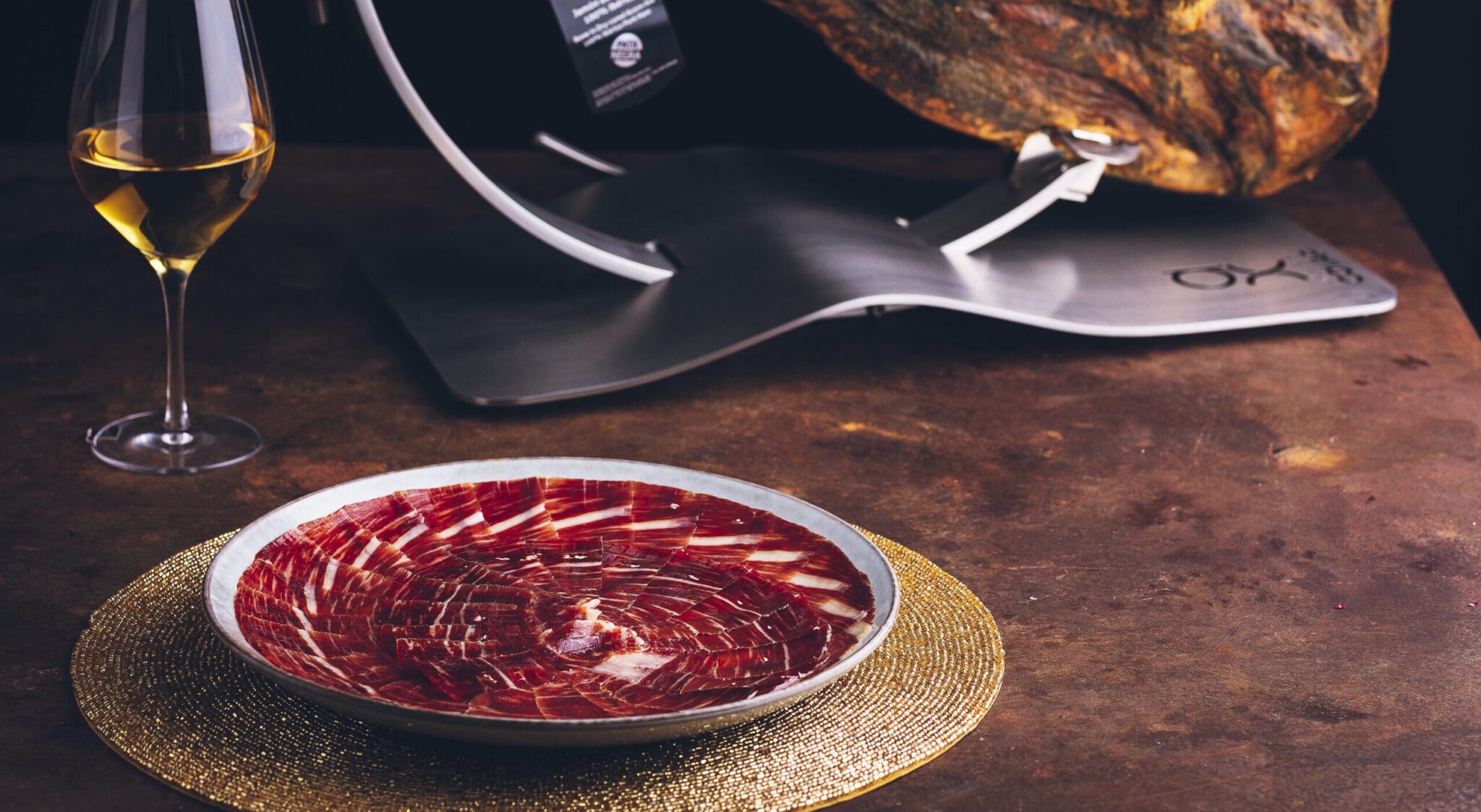
29 Oct Iberico Ham: One of Spain’s Culinary Treasures
In Spanish culture, ham is much more than mere food. It’s a staple of Spanish life, holding centre stage on celebratory tables and served throughout the country in bars and restaurants.
But not all hams are created equal.
Meticulously crafted from a unique breed of Iberian pigs, Iberico ham is an undisputed champion of Spanish gastronomy. With a history stretching back centuries, the production of this culinary treasure has evolved into an art form. From the region where it’s made to the way that it’s cut, every element contributes to its unique, nutty flavour, gloriously silky texture, and sweet, smoky aroma.
Internationally acclaimed as the caviar of cured hams, Iberico ham is a true taste sensation – and today’s post is all about this mouthwatering Spanish treasure. By the time you’ve discovered how Iberico ham is made, what those labels really mean and the best ways to taste it here in Spain, you’ll see exactly why we’ve crafted an entire tour dedicated to one of Spain’s best-loved culinary icons.
What Is Iberico Ham?
Let’s start with the basics. Spain has two main categories of artisan cured hams: Serrano and Iberico. Serrano is the most common, made across Spain from white pig breeds and cured in mountain air for between six and eighteen months. In contrast, the highly revered Iberico ham represents a fraction of Spain’s ham production and comes exclusively from the regions of Andalucia, Extremadura and Salamanca.
Iberico ham – also known as jamón Ibérico or pata negra – is the cured hind leg of the Iberian pig, a semi-wild breed of ancient pig found exclusively in Spain and Portugal, with origins dating back to Neolithic times. These pigs are renowned for their lean bodies, long, slender legs, sensitive snouts, and distinctive black hooves (hence the term pata negra, which means black hoof).
Central to the magic of Iberico ham is the pig’s diet and lifestyle. These animals roam freely in Mediterranean woodland known as dehesa, feasting on acorns during the montanera (the final fattening phase). This diet infuses the meat with its trademark sweet, nutty flavour and healthy, unsaturated fats, which set it apart from other cured hams.
The Dehesa Ecosystem: The Unique Lifestyle of Iberian Pigs
Iberico ham begins in one of Europe’s most stunning landscapes, the dehesa. Unique to the Iberian Peninsula, this privileged natural environment comprises vast pasturelands, dotted with holm and cork oak trees and carpeted in grass, wildflowers and aromatic herbs.
Free-roaming Iberian pigs gorge on between 6 and 8 kilos of acorns (bellotas) per day between October and March, supplemented by grass, flowers and herbs. The oak trees also provide shade, contributing to an ideal microclimate for the pigs – in addition to those all-essential acorns!
This richly diverse habitat has declined in size over the years, with four distinct regions left: Extremadura, Guijuelo in Salamanca, Jabugo in Huelva and Los Pedroches in Cordoba. At least a hectare of healthy dehesa is required to raise a single pig and, with many trees dating back several hundred years, the prospects for reforesting lost dehesa are slim.
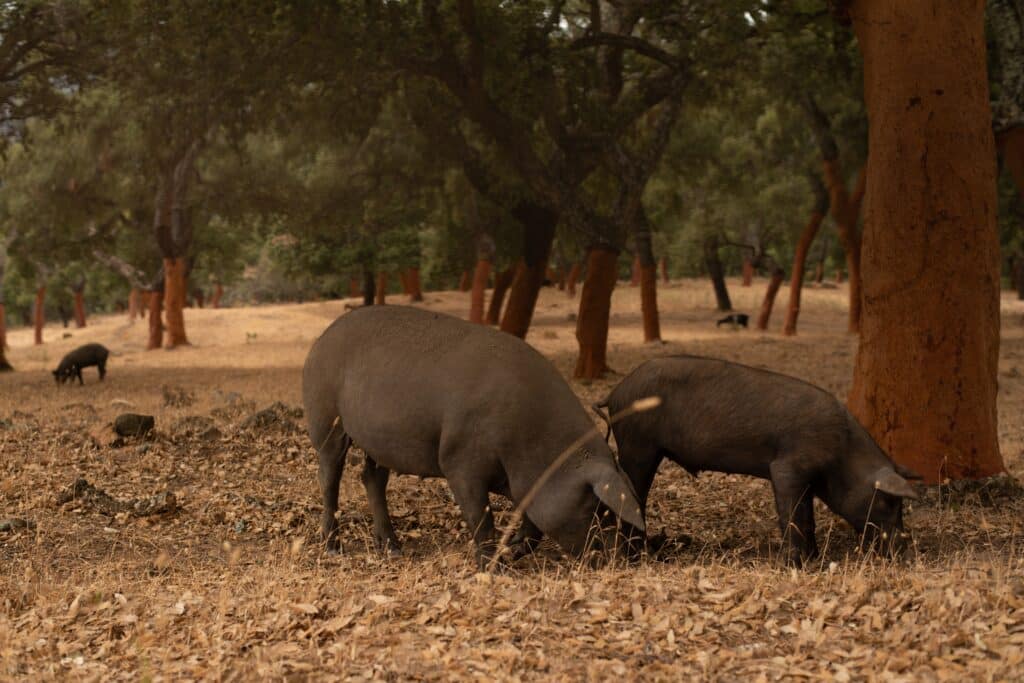
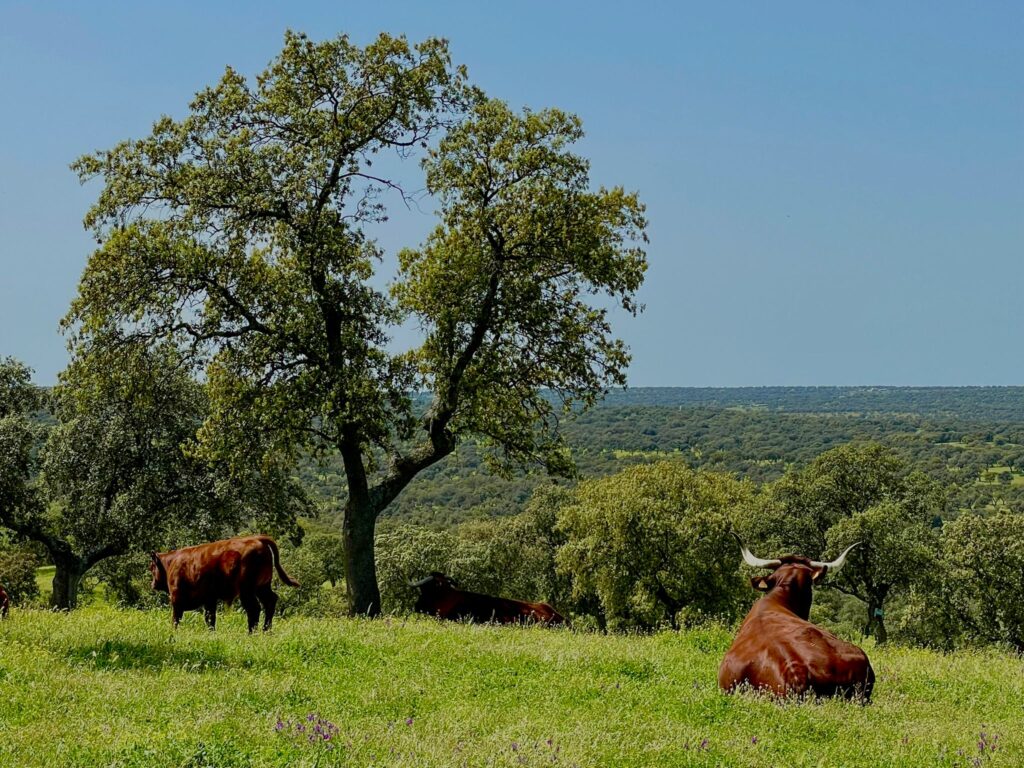
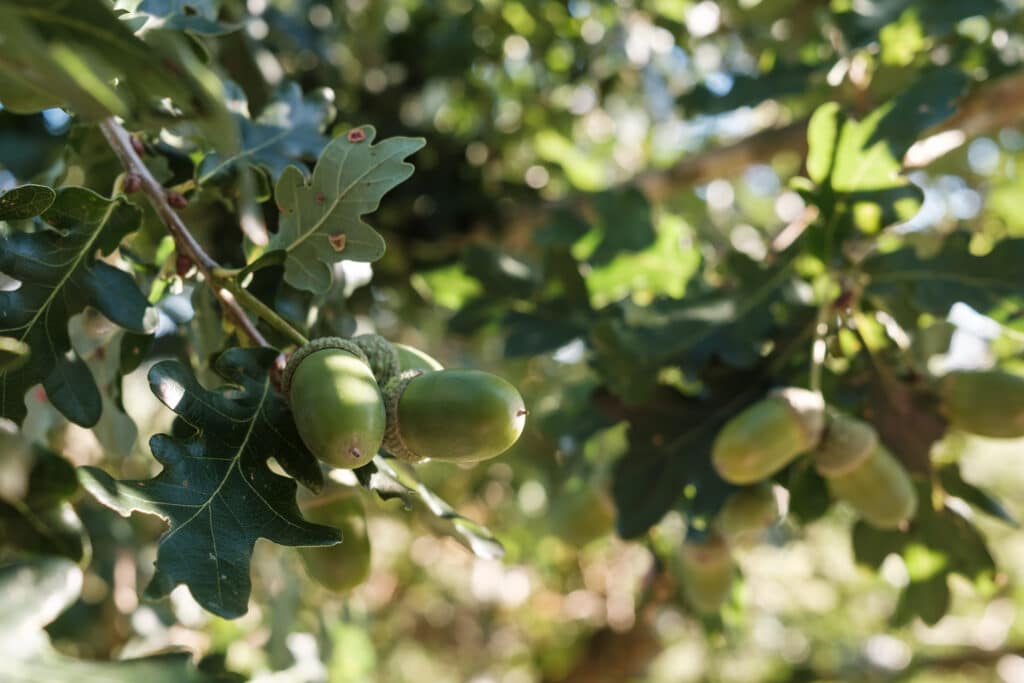
The Art of Curing Iberico Ham
From farm to plate, Iberico ham is the result of years of expertise, patience and a deep respect for quality. This artisanal process follows techniques honed over centuries and passed down from generation to generation. The process consists of several stages:
- Salting: The hams are trimmed, weighed and covered with wet salt in a special chamber kept at 90% humidity.
- Washing and resting: After being carefully rinsed to remove excess salt, they’re rested in refrigerated chambers for one to two months to remove the moisture and allow the salt to evenly penetrate the meat.
- Drying and maturation: Next, they’re hung in natural drying rooms for six to nine months, where airflow and climate are carefully managed to promote the development of those characteristic aromas.
- Aging in cellars: Finally, these pampered hams are cured in cool cellars for 24 to 48 months, where they acquire their unique flavour and texture.
When the ham has matured, a cala is inserted by the jamon master to determine when it’s ready for sale.
Recognising Quality: Iberico Ham Classifications
So how can you spot a good quality ham? Spain has four official classifications of Iberico ham, tied to the pig’s breed and diet.
- Black label (100% Iberico de bellota): This is the highest quality ham, made from purebred pigs, raised free-range and fed exclusively on acorns.
- Red label (50-75% Iberico de bellota): Crossbred pigs that are also free-range and acorn-fed.
- Green label (Iberian cebo de campo): Purebred or crossbred Iberian pigs raised in the dehesa but fed additional grain fodder, resulting in an intense taste and chewy texture.
- White label (Iberian cebo): Purebred or crossbred Iberian pigs that are intensively farmed, do not roam freely and are fed on cereals and natural feed instead of acorns.
How to Taste Iberico Ham
While Iberico ham is sold throughout the world, nowhere is it savoured with as much pride and ceremony as in Spain itself. This king of meats can be found in tapas bars and restaurants, in regional markets and specialist tasting shops, indeed barely a day passes in Spain without being offered a plate of jamon! You can also visit the producers to see first-hand how the pigs are raised, learn about the production process, and sample this delicacy while gazing across picturesque dehesas.
There’s a real art to the slicing, which is carried out in bars and restaurants by highly trained cortadores using a special slender knife, the cuchillo jamonero. They carve delicate, translucent slices, at room temperature, so the fat melts softly on the tongue and reveals a burst of sweet, nutty aromatics.
Simplicity is key. When eating Iberico ham for the first time, enjoy it simply as it is. Savouring a whole slice including muscle and fat allows you to experience the meat’s full complexity – the nutty undertones and sweet aroma, the rich, savoury flavour and satisfying, melt-in-the-mouth texture. If you want to pair it with something, a slice of bread rubbed with ripe tomato – pan con tomate – is a classic companion that allows the flavour of the ham to shine.
Naturally, you’ll probably want a little liquid refreshment alongside this treat. For the ultimate Spanish experience, pair acorn-fed Iberico ham with fortified wines, a bone-dry Fino or Manzanilla or a rich Amontillado work beautifully. A young, fruity red such as Rioja Crianza or Pinot Noir make a good combination, and if you’re feeling adventurous a sparkling Cava is perfect on a warm, sunny day. Sometimes a cool beer equally hits the spot!
Now for the good news. In addition to delivering a taste sensation, it’s also remarkably healthy. Acorn-fed Iberico ham is rich in protein, calcium, phosphorus, vitamins B1 and B2, and iron, while its high content of unsaturated fats, including oleic acid, are known to lower cholesterol and support cardiovascular health. This makes it an arguably better choice than other cured meats or even lean poultry.
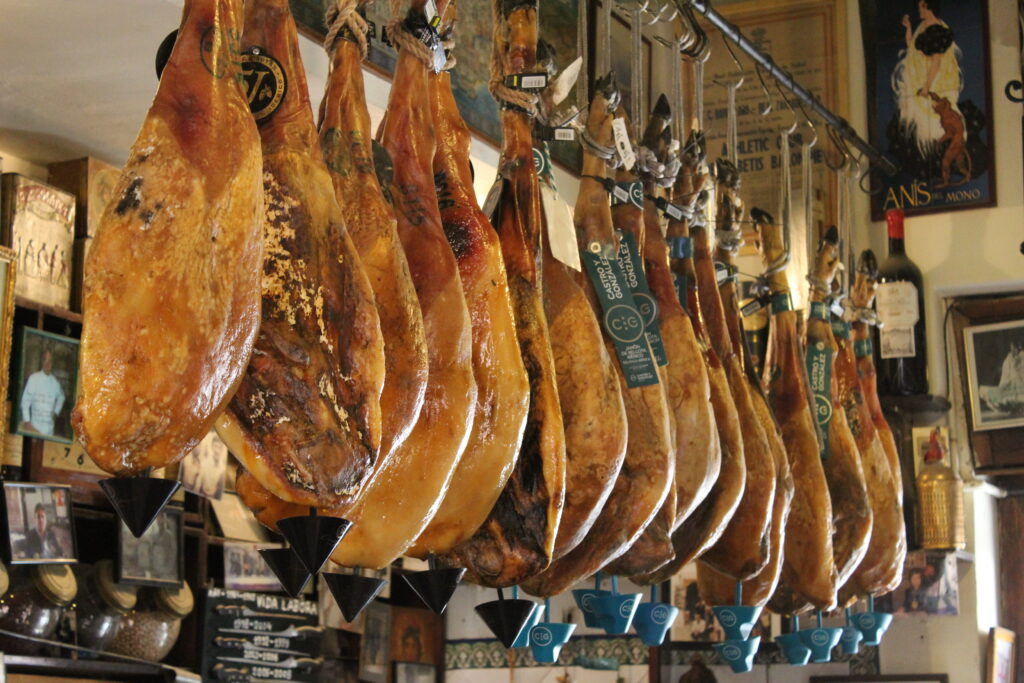
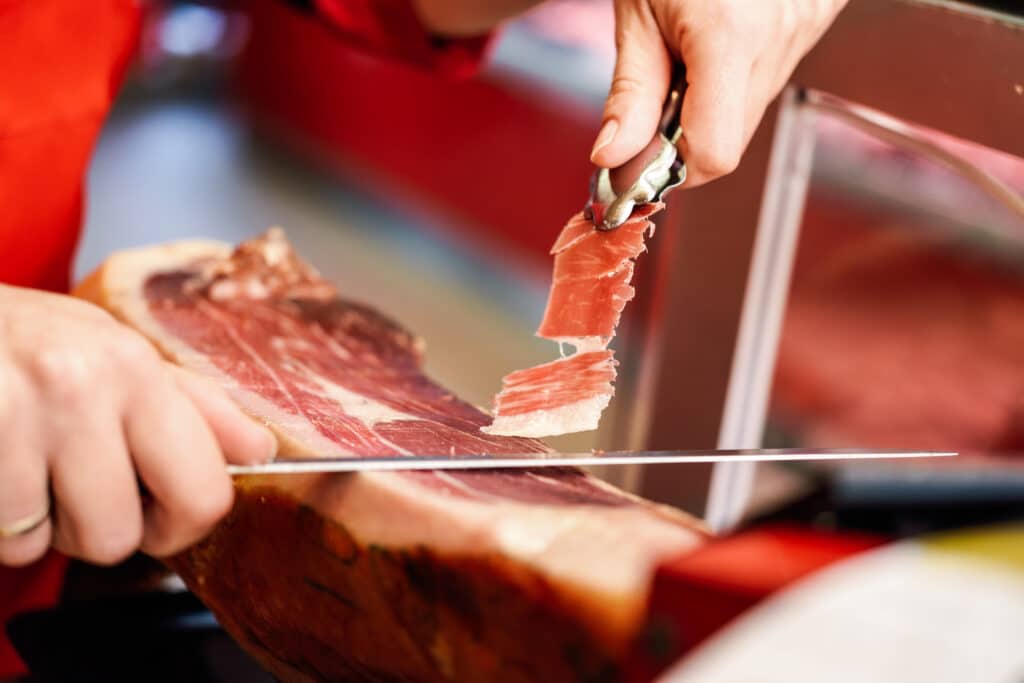
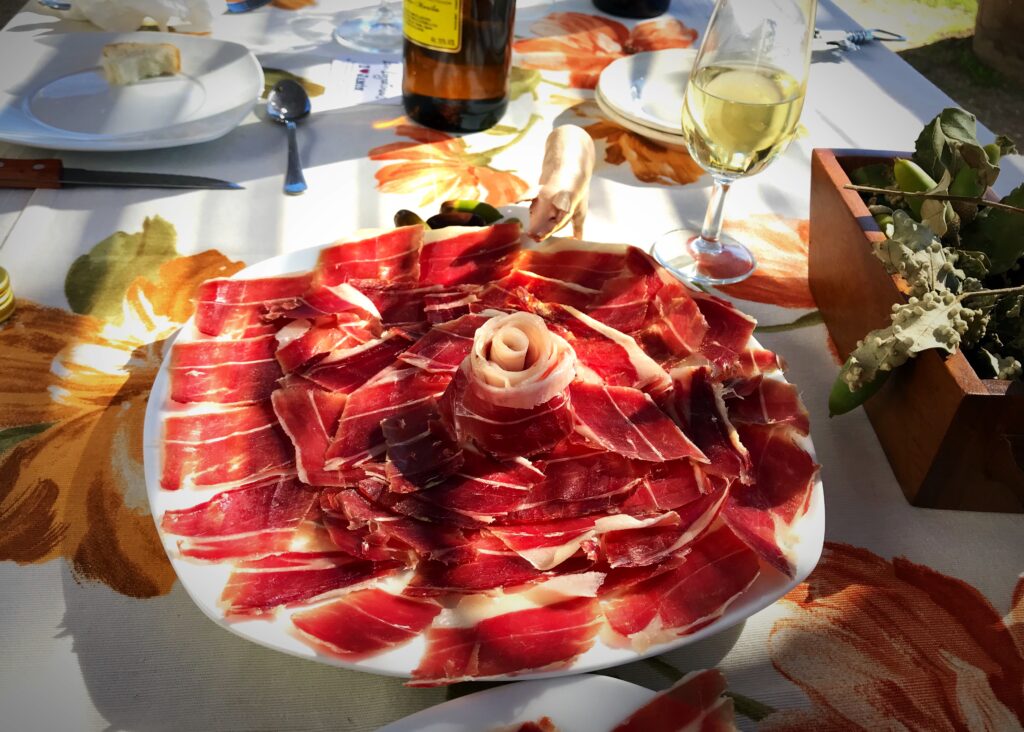
An Invitation to Experience Iberico Ham with Just Explore
Whether you’re a ham connoisseur or a curious foodie, our 15-day tailor-made Iberico ham tour offers the ultimate introduction to this culinary star. This unique and pioneering Spanish food tour introduces you to all four regions renowned for jamon Iberico. With insider access to local dehesas, you can see Iberian pigs in their natural environment, discover the whole process of Iberico ham production, and even try your hand at slicing. This tour is much more than just ham. You’ll visit other local producers and tour vineyards, sampling gastronomic delights including wine, olive oil, cheese and chocolate. Guided tours of Spanish cities, architectural and historic treasures, along a passionate flamenco show give you a flavour of Spanish culture, while guided hikes take you deep into nature.
Like all our tailor-made tours, our Iberico ham tour can be fully customised to suit your interests, tastes and budget. To find out more or to book this exclusive food tour, contact Just Explore today.


